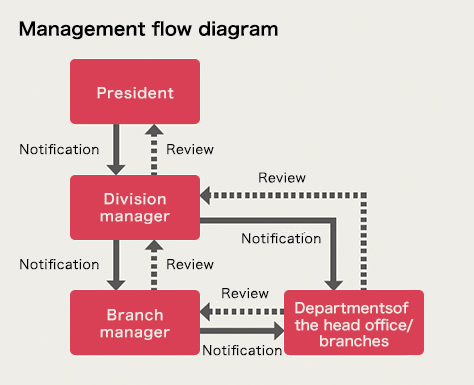Working practice
Policy/view
The largest asset of our company is “human resources.” Approximately over 3,000 employees work for our company, including those working overseas. We are working on efforts to “improve job satisfaction and ease when working” including the compliance with work-related laws and regulations in order to respond to the diversification of social problems and social needs, and enable various human resources to maximize their abilities regardless of gender, age, or nationality.
To prepare for the overtime limit regulation that will apply in April 2024, we have made efforts these past several years to grasp actual working hours and rectify long working hours. At each field office, to comply with the system of eight closure days in four weeks which is promoted by the Japan Federation of Construction Contractors, an annual plan is formulated and the status of progress is checked toward the achievement of the objective at all field offices.
In addition, we have continuously promoted the employees' acquisition of annual paid leave and the study on a flexible working style that fits the individual situation such as child rearing and caregiving, while grasping the actual state.
To further facilitate better working conditions, we consider it important not only to improve various systems, but also to foster a culture where employees can use them when it is necessary. Our company aims to achieve that through our efforts for diversity and inclusion.
Management
Our company specifies the “correction of long working hours (eradiation of overwork)” and “improvement of job satisfaction and ease when working” in the President’s annual policy, reflects it in the policies of division managers/branch managers, and the policies of departmental managers at the head office and branches in the form of an execution plan, and conducts periodical follow-ups in interviews with the President and with division managers and branch managers.
For the correction of long working hours (eradication of overwork), we aggregate the working hours of all employees on a monthly basis, have the aggregated information shared among executive officers higher than department managers, and conduct interviews with employees who worked overtime (over 80 hours including work on holidays) as required, in order to determine the cause, take necessary measures, and prevent health hazards for the employees.
To improve employees' job satisfaction and ease of working, we introduced a flextime system (with no core time, in principle) and are making efforts to promote a more flexible work style.

Results
In terms of the correction of long working hours, we consider that it is necessary to continue to implement various measures in the future on the grounds that partly due to the strong demand for construction behind the issue, working hours have not been substantially reduced.
Efforts to reduce long working hours
In our present system for recording working hours (attendance sheet), employees are responsible for reporting their working hours to their superior, who then approves the report. To ensure appropriate control of working hours, the log time (on/off time) on a personal computer used by each employee is referenced full-time to monitor any difference with the true status of working. For overtime work, the entire company has uniformly adopted a system under which it is essential to receive a work instruction from a superior.
In addition, we work to familiarize employees with the Agreement under Article 36 by posting the Agreement under Article 36 in notification form in a location where it will attract employees’ attention in all offices.
Labor agreement
Since our company does not have a labor union, we do not have a labor agreement. However, our company has signed an “Agreement under Article 36 (labor-management agreement),” created between the employer and the person representing the majority of workers, and specified an acceptable range of overtime work and work on holidays.
All business places of the head office and branches (a total of approximately 300 business places including field offices and sales offices) have signed the Agreement under Article 36 with about 100% employees excluding persons in managerial positions. We centrally manage the expiration dates of the Agreement and the maximum hours and days of overtime work/work on holidays specified under the Agreement stored in a database and check the contents for appropriateness.
In addition, we work to familiarize employees with the Agreement under Article 36 by posting the Agreement under Article 36 in notification form in a place where it will attract employees’ attention in all offices.
Wage system
Unit (yen)
| Average wage (annual) |
|
|---|---|
|
Managerial positions (M + S + Training + LP) |
9,563,978 |
|
General office worker |
5,246,914 |
|
Field worker |
3,942,873 |
Unit (yen)
| Breakdown of managerial positions | Average wage (annual) |
|---|---|
|
M (management) |
15,889,280 |
|
S (staff) |
10,085,035 |
|
Training |
5,776,918 |
|
LP (leading professional) |
15,495,569 |
* The average annual salary includes bonuses and extra wages.
Work-life balance related
![Labor, human rights, personnel affairs: [KPI] Labor (ii) Work-life balance related](/assets/images/english/csr/hrd/lp/lp_img03.jpg)